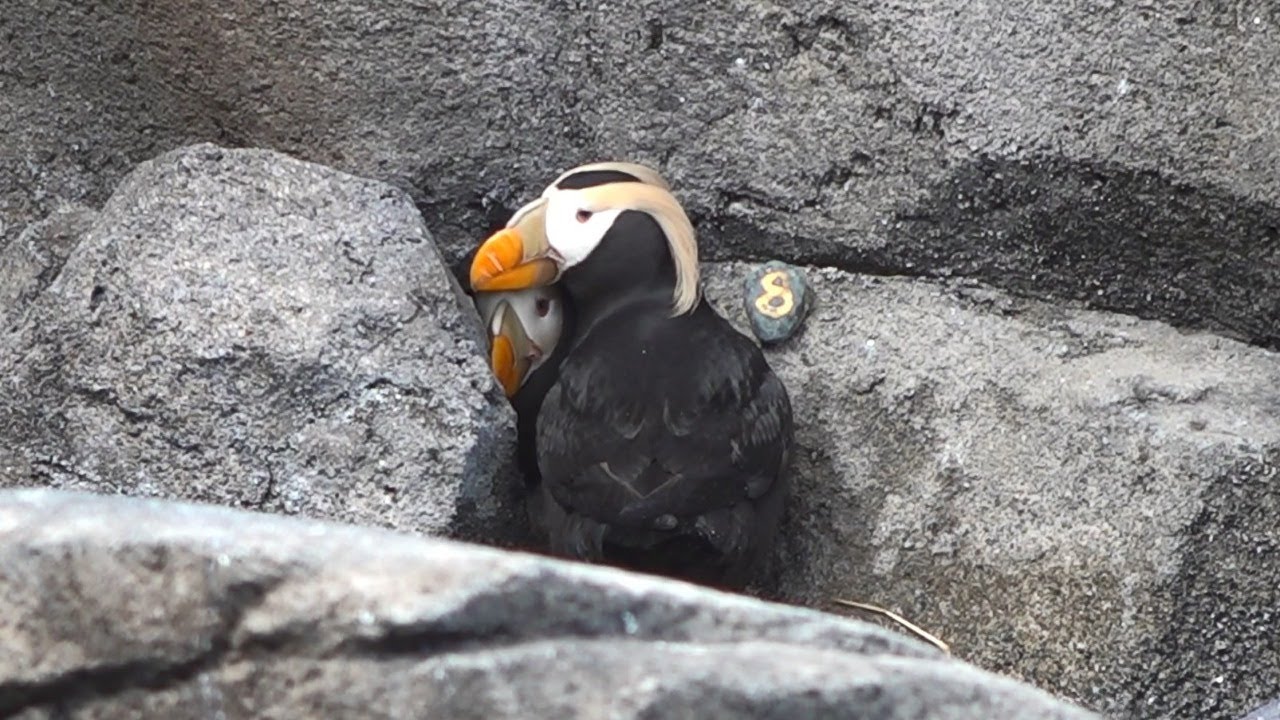*****
Summary of Transcript:
The narrator is at the Alaska Sealife Center’s aviary, where the birds have transitioned into nesting season. The red-legged kittiwakes are building mud nests, and the tufted puffins collect nesting materials and share the nesting duties equally. The males and females of the puffin species look the same, so they are banded to tell them apart. Waterfowl, like the king-eiders, have brightly colored males and camouflaged females. Courtship behaviors like head dips, wing displays, and vocalization can be seen between the birds, and the first birds likely to start nesting will be the Harlequin ducks. The common mers are a species of seabird that can still fly and dive down up to 600 feet underwater. They stand straight up and down because their feet act as rudders at the back of their body.
*****
Summary of Description:
The Alaska SeaLife Center‘s aviary has some exciting activities for spring, and you can join Darin to see what the birds are up to. The Center is also offering #telequarium programs every day, and donations to support their education programs are appreciated.
*****
Springtime in the ASLC’s Aviary: A Look at the Life of Birds
Birds are fascinating creatures known for their beauty, intelligence, and musicality. They move elegantly and live in harmony with their environment. If you love birds and want to learn more about them, join Darin in the ASLC’s aviary for an exciting adventure.
Exploring the Aviary
The ASLC’s aviary is a large and spacious area with trees, plants, rocks, and water features. It provides a natural and comfortable habitat for birds, many of whom are native to Alaska. As you walk into the aviary, you can hear birds chirping, singing, and whistling.
The birds in the aviary belong to different species, each with unique characteristics and behaviors. There are gulls, terns, puffins, crows, ravens, ducks, and more. The birds have plenty of space to fly, swim, and socialize, making the aviary an exciting and dynamic environment.
Observing the Birds
Darin, an ASLC educator, leads us on an aviary tour. He points out different bird species and explains their behaviors, habits, and health status.
We see the puffins, one of the most popular birds in Alaska. They have striking black and white feathers, a colorful beak, and comical expressions that make them endearing. We learn that puffins are excellent divers who can hold their breath for over a minute and swim up to 60 feet underwater.
We also meet the common murre, a bird with a distinctive long bill and black and white plumage. They have a unique way of communicating with each other, using a special call that is harmonic and soothing.
Darin shows us the crows, which are brilliant and adaptable birds. They have a reputation for being resourceful, cunning, and opportunistic. We learn that crows can recognize human faces, use tools to solve problems, and even prank their peers.
Finally, we visited the ducks, which are graceful and elegant birds. The ducks swim in the serene pond, enjoying the sunlight and the water. We learn that ducks have different feathers for insulation, buoyancy, and waterproofing. We also know that ducks are social creatures, often forming strong bonds with their mates and offspring.
Learning from the Birds
The ASLC’s aviary is not just a place for sightseeing; it is also a hub for education and conservation. The Center teaches visitors the importance of protecting birds and their habitats through programs, workshops, and exhibits.
Darin explains that many bird species are in danger due to human intervention, climate change, and habitat loss. He emphasizes that everyone has a role in preserving bird populations and their ecosystems. By supporting education, research, and conservation programs, we can positively impact the environment and help ensure a bright future for birds and other wildlife.
Joining the Cause
Consider donating to join the ASLC’s mission and support its educational programs. Your contribution can provide resources, equipment, and opportunities for children, families, and the community to learn about birds and their importance to the planet.
Conclusion
The ASLC’s aviary is a unique and special place, a sanctuary for birds and a window into their world. Through this adventure, we have learned about the beauty, diversity, and fragility of birds and their habitats. We have also known about the crucial role of education and conservation in securing their future. So, next time you are in Alaska, don’t miss the opportunity to visit the ASLC’s aviary and see the birds up close.
*****
Source Description
Join Darin in the ASLC’s aviary to see what the birds are doing this spring!
Join us for our #telequarium programs every day.
The value you place on the Alaska SeaLife Center’s education programs connects you to the Center’s mission. Your gift helps maintain our education programs and is much appreciated. https://www.alaskasealife.org/donate


